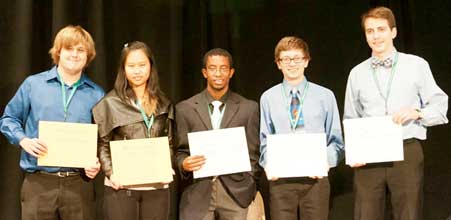Students Garner Forum Awards for Poster Papers at SPS Conference
Forum News
The Society of Physics Students (SPS) 2012 Quadrennial Physics Congress took place in Orlando, Florida, over November 8-10, 2012. The Forum on Physics and Society sponsored three awards for student poster papers: one first-place and two second-place awards for posters which included the societal impact of physics as part of their studies. Of a total of nearly 200 posters, over 90 wished to be considered for the awards. Posters were judged by three different faculty members or trained physics/astronomy professionals. The first-place award was $500 plus complimentary registration at either the March or April APS meeting. The second-place awards were each $250. All three winners also received certificates that featured both the APS and PhysCon logos, and signed copies of one of Lawrence Krauss’ popular books. The first place winner was Allen Scheie (Grove City College), and the second-place winners were Kofi Christie (Morehouse College) and Matthew Goszewski (Grove City College). Two honorable mention recipients also received certificates: Jeremy Johnson (Angelo State University), and Yulu Liu (Southeast University, China). We congratulate the winners and their schools.

APS Forum on Physics & Society Student Poster Award winners at PhysCon. L-R: Jeremy Johnson (Angelo State University), Yulu Liu (Southeast University), Kofi Christie (Morehouse College), Matthew Goszewski (Grove City College), and Allen Scheie (Grove City College). Photo by Ken Cole.
Abstracts of the winning posters:
The Science Committee: Science Policy on Capitol Hill
Allen Scheie, Grove City College
This summer, I worked as an intern with the U.S. House of Representatives Committee on Science, Space, and Technology, as a John Mather Public Policy Intern. The Science Committee oversees federal science policy, as well as NSF, NIST, NASA, and parts of the EPA, the FAA, and the Department of Homeland Security. As an intern, I assisted with congressional hearings, researched policy initiatives for the committee staff, and built databases. A few of the topics I covered this summer included spaceflight policy, endangered species policy, drought monitoring, hazardous chemical disposal, environmental regulation, and open-access publishing. The purpose of this internship was to get physics students involved with public policy, to develop both scientists who understand policy as well as politicians who understand science. Not only is the federal government is one of the largest funders of basic research, but many problems the United States faces have technical aspects and it is imperative that politicians understand the strengths and weaknesses of the scientific process.
Terahertz Time Domain Spectroscopy of Gold Nanorods
Kofi Christie, Morehouse College
Nanoparticles have distinct electrical and vibrational properties from bulk materials originating from the quantum confinement and surface effect. Bioengineers are currently able to exploit these properties for applications in biosensing, using the surface plasmon resonance wavelength of gold nanorods to monitor changes in their local environment. THz-TDS provides scientists with new opportunities to study low frequency phonons, and low frequency phonons in gold nanoparticles are explicatory of their morphology. Here, terahertz time-domain spectroscopy (THz-TDS) was used to study the vibrational behavior of gold nanorods embedded in a poly (vinyl alcohol) matrix. The nanorods’ aspect ratios (diameter x length) of 30.7 x 81.6 nm, 30.7 x 84.0 nm, 16.2 x 39.5 nm, 18.7 x 52.2 nm, and 18.5 x 56.5 nm are confirmed by visible/near-infrared absorption spectroscopy and transmission electron microscopy. The frequencies of the phonon modes are expected to be proportional to the longitudinal and transverse sound velocity in the material and inversely proportional to the size of the Au nanorods. We discuss how THz-TDS offers a solid method to determine nanoparticle morphology.
PhysicsQuest: Bringing Super Powers to Life
Matthew Goszewski, Grove City College
This summer I had the opportunity to intern with the Society of Physics Students and the American Physical Society. I was in the APS Public Outreach department and worked on the PhysicsQuest: SPECTRA comic book. My task was to create demonstrations that middle school teachers would be able to present in their classrooms, using easy-to-find materials, that compliment the physics in the current SPECTRA issue. My Poster will reflect the steps needed for creating a well-written, well -researched, and reliable physics demo.
These contributions have not been peer-refereed. They represent solely the view(s) of the author(s) and not necessarily the view of APS.
